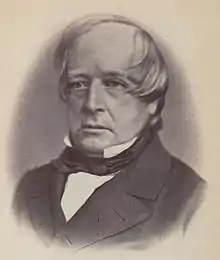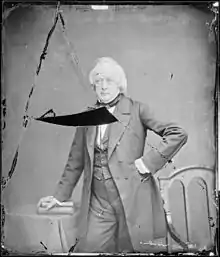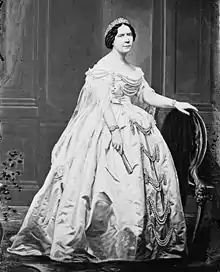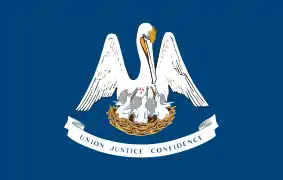John Slidell
John Slidell (1793 – July 9, 1871) was an American politician, lawyer, and businessman. A native of New York, Slidell moved to Louisiana as a young man and became a Representative and Senator. He was one of two Confederate diplomats captured by the United States Navy from the British ship RMS Trent in 1861 and later released. He was the older brother of Alexander Slidell Mackenzie, a US naval officer.
John Slidell | |
|---|---|
 | |
| United States Senator from Louisiana | |
| In office December 5, 1853 – February 4, 1861 | |
| Preceded by | Pierre Soulé |
| Succeeded by | William P. Kellogg |
| Member of the U.S. House of Representatives from Louisiana's 1st district | |
| In office March 4, 1843 – November 10, 1845 | |
| Preceded by | Edward Douglass White, Sr. |
| Succeeded by | Emile La Sére |
| Member of the Louisiana House of Representatives | |
| Personal details | |
| Born | 1793 New York City, New York |
| Died | July 9, 1871 (aged 77–78) Cowes, Isle of Wight, England |
| Political party | Democratic |
| Spouse(s) | Mathilde Deslonde Slidell |
| Children | Alfred Marie Matilda |
| Alma mater | Columbia College |
| Profession | Politician, Lawyer, Merchant |
Early life
He was born to merchant John Slidell and Margery née Mackenzie, a Scot. He graduated from Columbia University (then College) 1810. In 1835, Slidell married Mathilde Deslonde. They had three children, Alfred Slidell, Marie Rosine (later [on 30 Sept. 1872] comtesse [Countess] de St. Roman), and Marguerite Mathilde (later [on 3 Oct. 1864] baronne [Baroness] Frederic Emile d'Erlanger).[1]

Political career
Slidell was in the mercantile business in New York before he relocated to New Orleans. He practiced law in New Orleans from 1819 to 1843. He was the district attorney in New Orleans from 1829 to 1833. He also served in the state's House of Representatives from 1837 to 1838.[2] Though he lost an election to the United States House in 1828, he was elected in 1842 and served a term and a half from 1843 to 1845, as a Democrat.[3] He served as minister plenipotentiary to Mexico from 1845-1846.
Prior to the Mexican–American War, Slidell was sent to Mexico, by President James Knox Polk, to negotiate an agreement whereby the Rio Grande would be the southern border of Texas. He also was instructed to offer, among other alternatives, a maximum of $25 million for California by Polk and his administration.[4] Slidell warned Polk that the Mexican reluctance to negotiate a peaceful solution might require a show of military force to defend the border by the United States. Under the command of General Zachary Taylor, U.S. troops were sent into the disputed area between the Rio Grande and Nueces Rivers. The Mexican government, in a state of chaos at the time, rejected Slidell's mission. After Mexican forces repelled a U.S. scouting expedition, the United States declared war on Mexico on May 13, 1846.
Slidell was elected to the Senate in 1853 and cast his lot with other pro-Southern congressmen to repeal the Missouri Compromise, acquire Cuba, and admit Kansas as a slave state. In the 1860 campaign Slidell supported Democratic presidential candidate John C. Breckinridge, but remained a pro-Union moderate until Abraham Lincoln's election resulted in the Southern states seceding. At the Democratic National Convention in Charleston, South Carolina, in April 1860, Slidell plotted with "Fire-Eaters" such as William Lowndes Yancey of Alabama to stymie the nomination of the popular Northern Democratic Senator Stephen A. Douglas of Illinois.
Civil War

With the passage of the Louisiana ordinance of secession, Slidell resigned from the Senate and headed home. In a dramatic farewell address, he threatened the boycott of all northern manufacturing and predicted the dominance of southern ships on the seas. He argued that foreign countries would prevent the Union from blockading southern ports: he promised that the Confederate States would never fire the first shot but if the Union did so, "This will be war,... and we shall meet it with... efficient weapons."[5] The historian John D. Winters reports that many Confederates "still thought a peaceful solution could be found. Many believed the Yankee incapable of learning to use a gun or of mustering enough courage to fight; the emergency [they mistakenly thought] would soon dissipate."[6]
Slidell soon accepted a diplomatic appointment to represent the Confederacy in France. Slidell was one of the two Confederate diplomats involved in the Trent Affair in November 1861. After he was appointed the Confederate commissioner to France in September, 1861, he ran the blockade from Charleston, South Carolina, with James Murray Mason of Virginia. They then set sail from Havana on the British mail boat steamer RMS Trent but were intercepted by the US Navy while en route and taken into captivity at Fort Warren in Boston.
The Northern public erupted with a huge display of triumphalism at this dramatic capture. Even the cool-headed Lincoln was swept along in the celebratory spirit, but when he and his cabinet studied the likely consequences of a war with Britain, their enthusiasm waned. After some careful diplomatic exchanges, they admitted that the capture had been conducted contrary to maritime law and that private citizens could not be classified as "enemy despatches." Slidell and Mason were released, and war was averted.
After the resolution of the Trent Affair, the two diplomats set sail for England on January 1, 1862. From England, Slidell at once went to Paris, where, in February 1862, he paid his first visit to the French minister of foreign affairs. His mission to gain recognition of the Confederate States by France failed, as did his effort to negotiate a commercial agreement for France to get control of Southern cotton if the blockade were broken. In both cases, France refused to move without the co-operation of England.[7][8] He succeeded in negotiating a loan of $15,000,000 from Emile Erlanger & Co. and in securing the ship "Stonewall" for the Confederate government.[9][10]
Later life
Slidell moved to Paris, France, after the Civil War. He died in Cowes, Isle of Wight, England, at age 78. He is interred in the Saint-Roman family private cemetery near Paris.[11] He, Judah P. Benjamin and A. Dudley Mann were among the high-ranking Confederate officials buried abroad.
Family
Slidell was a brother of Alexander Slidell Mackenzie, a naval officer who commanded the USS Somers on which a unique event occurred in 1842 off the coast of Africa during the Blockade of Africa. Three crewmen were hanged after being convicted of mutiny at sea. Mackenzie reversed the order of his middle and last names to honor a maternal uncle.
Another brother, Thomas Slidell, was chief justice of the Louisiana Supreme Court. He was also the brother-in-law of the American naval Commodore Matthew C. Perry, who was married to Slidell's sister, Jane. Perry is remembered for opening United States trade with Japan in 1853.
Legacy
The city of Slidell in St. Tammany Parish, Louisiana, was named in his honor by his son-in-law Baron Frederic Emile d'Erlanger; the village of Slidell, Texas, is also named after him.[12]
References
- "Matilde d'Erlanger Slidell" (PDF). lasocr.org. Archived from the original (PDF) on 7 July 2012. Retrieved 9 April 2018.
- (PDF). 31 March 2010 https://web.archive.org/web/20100331104823/http://house.louisiana.gov/H_PDFdocs/HouseMembers1812_2008.pdf. Archived from the original (PDF) on 31 March 2010. Retrieved 9 April 2018. Missing or empty
|title=(help) - The Historical Atlas of Political Parties in the United States Congress, p. 97
- "Teaching With Documents: Lincoln's Spot Resolutions". U.S. National Archives. Cite journal requires
|journal=(help) - John D. Winters, The Civil War in Louisiana, Baton Rouge: Louisiana State University Press, 1963, ISBN 0-8071-0834-0, pp. 14-15
- Winters, p. 15
- Gilman, D. C.; Peck, H. T.; Colby, F. M., eds. (1905). . New International Encyclopedia (1st ed.). New York: Dodd, Mead.
- Rines, George Edwin, ed. (1920). . Encyclopedia Americana.
- Reynolds, Francis J., ed. (1921). . Collier's New Encyclopedia. New York: P. F. Collier & Son Company.
- Beach, Chandler B., ed. (1914). . . Chicago: F. E. Compton and Co.
- McKern, Bill. "John Slidell". Find A Grave. Retrieved 5 February 2018.
- "Handbook of Texas Online - Slidell, TX". Retrieved 2009-01-15.
- United States Congress. "John Slidell (id: S000487)". Biographical Directory of the United States Congress.
- "John Slidell", A Dictionary of Louisiana Biography, Vol. 2 (1988), pp. 746–747
- John Slidell (1793 - 1871), civilwarhome.com
Sources
- Case, Lynn M., and Warren E. Spencer. The United States and France: Civil War Diplomacy (1970)
- Sears, Louis Martin. "A Confederate Diplomat at the Court of Napoleon III," American Historical Review (1921) 26#2 pp. 255–281 in JSTOR on Slidell
- Sears, Louis Martin. John Slidell, Duke University Press (1925).
External links
| Wikimedia Commons has media related to John Slidell. |
- . Encyclopædia Britannica (11th ed.). 1911.
- John Slidell in the Louisiana Historical Association's Dictionary of Louisiana Biography
- John Slidell at Find a Grave
| U.S. House of Representatives | ||
|---|---|---|
| Preceded by Edward D. White, Sr. |
Member of the U.S. House of Representatives from Louisiana's 1st congressional district March 4, 1843 – November 10, 1845 |
Succeeded by Emile La Sére |
| U.S. Senate | ||
| Preceded by Pierre Soulé |
U.S. senator (Class 3) from Louisiana December 5, 1853 – February 4, 1861 Served alongside: Judah P. Benjamin |
Succeeded by William P. Kellogg(1) |
| Notes and references | ||
| 1. Because of Louisiana's secession, the Senate seat was vacant for seven years before Kellogg succeeded Slidell. | ||


